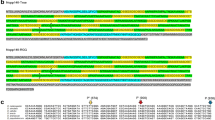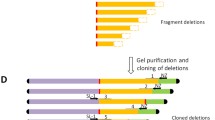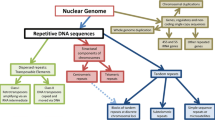Summary
By screening a cDNA library prepared from polyadenylated nuclear RNA of Xenopus laevis gastrula-stage embryos with total genomic DNA we have identified nine clones belonging to seven different families of repeated DNA. Two of these families exhibit partial sequence homologies and thus probably represent subfamilies of a common origin. The individual families comprise between 0.024% and 1.5% and, in total, about 2% of the X. laevis genome. Six of the clones elements represent dispersed repetitive DNA families; the seventh is mainly organized in a tandem fashion. Transcripts containing one type of repeat do not appear before the blastula stage and then accumulate in the course of development; however, the others can be detected within the unfertilized egg and their amount remains fairly constant throughout embryogenesis.
Similar content being viewed by others
References
Ackerman EJ (1983) Molecular cloning and sequencing of OAX DNA: an abundant gene family transcribed and activated in Xenopus oocytes. EMBO J 2:1417–1422
Anderson DM, Richter JD, Chamberlin ME, Price DH, Britten RJ, Smith LD, Davidson EH (1982) Sequence organization of the poly(A) RNA synthesized and accumulated in lampbrush chromosome stage Xenopus laevis oocytes. J Mol Biol 155:281–309
Anderson MLM, Young BD (1985) Quantitative filter hybridization. In: Homes BD, Higgins SJ (eds) Nucleic acid hybridization. IRL Press, Oxford, Washington DC, pp 73–111
Blin N, Stafford DW (1976) A general method for isolation of high molecular weight DNA from eukaryotes. Nucl Acid Res 3:2303–2308
Carroll D, Garrett JE, Lam BS (1984) Isolated clusters of paired tandemly repeated sequences in the Xenopus laevis genome. Mol Cell Biol 4:254–259
Chambers JC, Watanabe S, Taylor JH (1982) Dissection of a replication origin of Xenopus DNA. Proc Natl Acad Sci (USA) 79:5572–5576
Crampton J, Humphries S, Woods D, Williams R (1980) The isolation of cloned cDNA sequences which are differentially expressed in human lymphocytes and fibroblasts. Nucl Acid Res 8:6007–6017
Dawid IB (1965) Deoxyribonucleic acid in amphibian eggs. J Mol Biol 12:581–599
Davidson EH (1976) Gene activity in early development. Academic Press, New York San Francisco London 2nd ed
Davidson EH, Britten RJ (1979) Regulation of gene expression: possible role of repetitive sequences. Science 204:1052–1059
Denhardt DT (1966) A membrane-filter technique for the detection of complementary DNA. Biochem Biophys Res Common 23:641–646
Doolittle WF, Sapienza C (1980) Selfish genes, the phenotype paradigm and genome evolution. Nature (Lond) 284:601–603
Hummel S, Meyerhof W, Korge E, Knöchel W (1984) Characterization of highly and moderately repetitive 500 bp Eco RI fragments from Xenopus laevis DNA. Nucl Acid Res 12:4921–4938
Jamrich M, Warrior R, Steele R, Gall JG (1983) Transcription of repetitive sequences on Xenopus lampbrush chromosomes. Proc Natl Acad Sci (USA) 80:3364–3367
John ME, Meyerhof W, Knöchel W (1982) Developmentally regulated poly(A) containing RNA sequences in Xenopus laevis. In: Burger M, Weber R (eds) Embryonic development, part A: Genetic aspects. AR Liss Inc., New York, pp 149–158
Kay BK, Dawid IB (1983) the 1723 element: a long homogenous, highly repeated DNA unit interspersed in the genome of Xenopus laevis. J Mol Biol 170:583–596
Knöchel W, Bladauski D (1981) Cloning of cDNA sequences derived from poly(A)+ nuclear RNA of Xenopus laevis at different developmental stages: evidence for stage specific regulation. Wilhelm Roux's Arch 190:97–102
Knöchel W, Korge E, Basner A, Meyerhof W (1986) Globin evolution in the genus Xenopus: comparative analysis of cDNA coding for adult globin polypeptides of Xenopus borealis and Xenopus tropicalis. J Mol Evol (in press)
Lam BS, Carroll D (1983a) Tandemly repeated DNA sequences from Xenopus laevis I. Studies on sequence organization and variation in satellite 1 DNA (741 base-pair repeat). J Mol Biol 165:567–585
Lam BS, Carroll D (1983b) Tandemly repeated DNA sequences from Xenopus laevis II. Dispersed clusters of a 388 base-pair repeating unit. J Mol Biol 165:587–597
Maniatis T, Fritsch EF, Sambrook J (1982) Molecular cloning. A laboratory manual. Cold Spring Harbor Laboratory, Cold Spring Harbor Laboratory, Cold Spring Harbor, New York
Martens GJM, Herbert E (1984) Polymorphism and absence of leu-enkephalin sequences in proenkephalin genes in Xenopus laevis. Nature (Lond) 310:251–254
Maxam AM, Gilbert W (1980) Sequencing end-labeled DNA with base-specific chemical cleavages. Meth Enzym 65:499–560
Méchali M, Kearsey S (1984) Lack of specific sequence requirement for DNA replication in Xenopus eggs compared with high sequence specifity in yeast. Cell 38:55–64
Meyerhof W, John ME, Thomaschek G, Knöchel W (1982) Repetitive sequences associated with polyadenylated RNA of Xenopus laevis embryos. Wilhelm Roux's Arch 191:366–370
Meyerhof W, John ME, Knöchel W (1983a) Characterization of a cloned repeat element derived from polyadenylated nuclear RNA from gastrula stages of Xenopus laevis. In: Nagley P, Linane AW, Peacock WI, Pateman JA (eds) Manipulation and expression of genes in eukaryotes. Academic Press, Sidney, Australia
Meyerhof W, Tappeser B, Korge E, Knöchel W (1983b) Satellite DNA from Xenopus laevis: comparative analysis of 745 and 1037 base pair Hind III tandem repeats. Nucl Acid Res 11:6997–7009
Newport J, Kirschner M (1982a) A major developmental transition in early Xenopus embryos: I. characterization and timing of cellular changes at the midblastula stage. Cell 30:675–686
Newport J, Kirschner M (1982b) A major developmental transition in early Xenopus embryos: II. control of the onset of transcription. Cell 30:687–696
Nieuwkoop PD, Faber J (1975) Normal table of Xenopus laevis (Daudin). North-Holland Publishing Company, Amsterdam
Orgel LE, Crick FHC (1980) Selfish DNA: the ultimate parasite. Nature 284:604–607
Pardue ML, Brown DD, Birnstiel ML (1973) Location of the genes for 5 S ribosomal RNA in Xenopus laevis. Chromosoma 42:191–203
Perlman S, Rosbash M (1978) Analysis of Xenopus laevis ovary and somatic cell polyadenylated RNA by molecular hybridization. Dev Biol 63:197–212
Probst E, Kressman A, Birnstiel ML (1979) Expression of sea urchin histone genes in the oocyte of Xenopus laevis. J Mol Biol 135:709–732
Reith W, Spohr G (1984) Identification of Xenopus laevis mRNAs with homology to repetitive sequences. Nucl Acid Res 12:8899–8916
Richter JD, Smith LD, Anderson DM, Davidson EH (1984) Interspersed poly(A) RNAs of amphibian oocytes are not translatable. J Mol Biol 173:227–241
Roe BA, Ma DP, Wilson RK, Wong JFH (1985) The complete nucleotide sequence of the Xenopus laevis mitochondrial genome. J Biol Chem 260:9759–9774
Rosenthal DS, Doering JL (1983) The genomic organization of dispersed tRNA and 5 S RNA genes in Xenopus laevis. J Biol Chem 258:7402–7410
Roychoudhury R, Jay E, Wu R (1976) Terminal labeling and addition of homopolymer tracts to duplex DNA fragments by terminal deoxynucleotidyl transferase. Nucl Acid Res 3:101–116
Spohr G, Reith W, Sures I (1981) Organization and sequences analysis of a cluster of repetitive DNA elements from Xenopus laevis. J Mol Biol 151:573–592
Spohr G, Reith W, Crippa M (1982) Structural analysis of a cDNA clone from Xenopus laevis containing a repetitive sequence element. Dev Biol 94:71–78
Schubiger JL, Germond JE, ten Heggeler B, Wahli W (1985) The Vi element. A transposon-like repeated DNA sequence interspersed in the vitellogenin locus of Xenopus laevis. J Mol Biol 186:491–503
Tymowska J, Kobel HR (1972) Karyotype analysis of Xenopus muelleri (Peters) and Xenopus laevis (Daudin), Pipidae. Cytogen 11:270–278
Author information
Authors and Affiliations
Rights and permissions
About this article
Cite this article
Meyerhof, W., Korge, E. & Knöchel, W. Characterization of repetitive DNA transcripts isolated from a Xenopus laevis gastrula-stage cDNA clone bank. Roux's Arch Dev Biol 196, 22–29 (1987). https://doi.org/10.1007/BF00376019
Received:
Accepted:
Issue Date:
DOI: https://doi.org/10.1007/BF00376019




